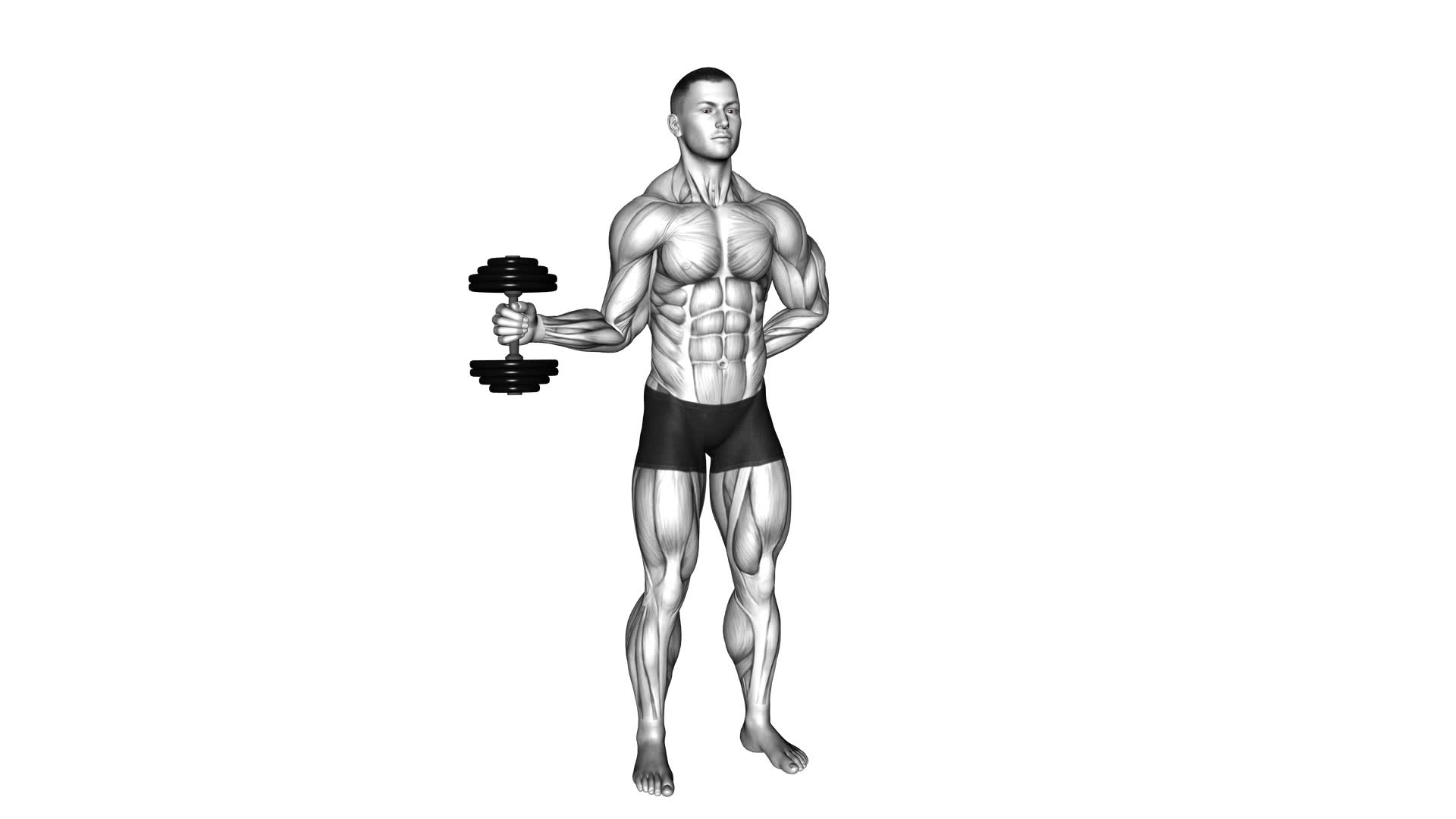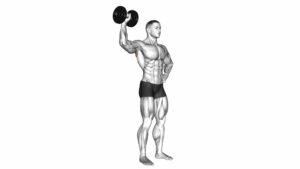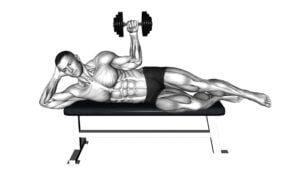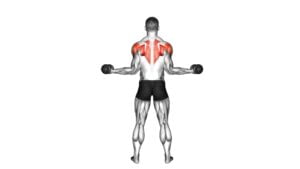Dumbbell External Rotation – Video Exercise Guide & Tips

Looking to strengthen your shoulders and improve your overall upper body strength? Check out this video exercise guide on dumbbell external rotation.
Watch This Exercise Video
In just a few minutes, you'll learn the proper form and technique for this effective exercise.
With tips on equipment setup, variations, and common mistakes to avoid, you'll be well-equipped for a safe and effective workout.
Get ready to take your shoulder training to the next level!
Key Takeaways
- Dumbbell external rotation strengthens and stabilizes shoulder muscles.
- Proper form and technique include keeping the elbow close to the body and the arm parallel to the floor.
- Common mistakes to avoid include allowing the elbow to move away from the body and using excessive weight that compromises form.
- Choosing the appropriate weight and maintaining proper alignment are essential for maximizing the benefits of dumbbell external rotation.
Benefits of Dumbbell External Rotation
One major benefit of dumbbell external rotation exercises is that they strengthen and stabilize the muscles in your shoulders. This is crucial for maintaining shoulder health and promoting overall upper body strength. By performing this exercise, you can target the rotator cuff muscles, which play a vital role in shoulder stability. Strengthening these muscles can help prevent injuries, such as dislocations or impingements, and improve your posture.
The dumbbell external rotation specifically targets the infraspinatus and teres minor muscles, which are responsible for external rotation of the shoulder joint. By regularly incorporating this exercise into your workout routine, you can enhance the strength and endurance of these muscles. This not only improves your ability to perform various upper body exercises but also enhances your overall shoulder stability during daily activities.
Furthermore, strong and stable shoulders are essential for performing other compound exercises such as bench presses, overhead presses, and pull-ups. By strengthening the muscles involved in external rotation, you can improve your overall upper body strength, leading to better performance in these exercises.
Proper Form and Technique
To perform the dumbbell external rotation exercise with proper form and technique:
- Hold a dumbbell in your hand and keep your elbow close to your body.
- Start by standing with your feet shoulder-width apart and your knees slightly bent.
- Hold the dumbbell in your hand with an overhand grip.
- Extend your arm out to the side, parallel to the floor.
- Keep your elbow bent at a 90-degree angle throughout the exercise.
Proper technique is crucial for maximizing the benefits of the dumbbell external rotation exercise and minimizing the risk of injury.
One common error to avoid is allowing your elbow to move away from your body as you rotate the dumbbell. This can lead to improper muscle activation and strain on the shoulder joint.
Another common mistake is using excessive weight, which can compromise your form and put unnecessary stress on your shoulder. It's important to start with a weight that allows you to maintain proper technique and gradually increase the weight as you become stronger and more comfortable with the exercise.
Equipment and Setup
You can use a dumbbell and set up your equipment for the dumbbell external rotation exercise. Here are three important items to consider for proper equipment setup:
- Choose the right weight: Select a dumbbell that's appropriate for your strength level. Start with a lighter weight and gradually increase as you become more comfortable with the exercise.
- Position yourself correctly: Stand with your feet shoulder-width apart and hold the dumbbell in one hand. Keep your back straight and engage your core muscles for stability.
- Maintain proper alignment: Extend your arm out to the side, forming a 90-degree angle with your elbow. Ensure that your wrist is in a neutral position and your shoulder is relaxed. This alignment will help target the correct muscles and prevent strain.
Proper equipment setup is crucial for maximizing the benefits of the dumbbell external rotation exercise. By using the right weight and maintaining proper alignment, you can effectively strengthen your rotator cuff muscles and improve shoulder stability.
Remember to always consult with a fitness professional before starting any new exercise program to ensure proper form and technique.
Common Mistakes to Avoid
When performing dumbbell external rotations, it's important to avoid common mistakes that can hinder your progress and potentially lead to injury.
One common mistake is incorrect arm position, where the elbow isn't properly aligned with the shoulder. This can limit the effectiveness of the exercise and put unnecessary strain on the joints.
Another mistake to avoid is lack of shoulder stability, where you allow your shoulder to sag or rotate during the movement. This can compromise the targeted muscles and increase the risk of injury.
Lastly, overloading the weight is a mistake that can lead to poor form and compensation from other muscles, rather than targeting the intended muscles.
Stay mindful of these common mistakes to ensure you get the most out of your dumbbell external rotation exercise.
Incorrect Arm Position
Avoid extending your arm too far back during the dumbbell external rotation exercise. This is an improper technique that can increase the risks of shoulder injury. To ensure proper form and minimize the chance of injury, keep the arm at a comfortable angle throughout the exercise.
Here are three reasons why maintaining the correct arm position is crucial during the dumbbell external rotation exercise:
- Reduced strain: Extending your arm too far back puts excessive strain on the shoulder joint, increasing the risk of overuse injuries.
- Proper muscle activation: Maintaining the correct arm position allows for optimal activation of the muscles involved in the exercise, ensuring effective strengthening and stability.
- Improved range of motion: By keeping the arm at a comfortable angle, you can safely work on improving your shoulder's range of motion without compromising joint integrity.
Lack of Shoulder Stability
Maintain proper shoulder stability to avoid common mistakes during the dumbbell external rotation exercise. Shoulder instability can lead to poor form and decreased effectiveness of the exercise. To prevent this, focus on engaging the muscles around the shoulder joint and maintaining control throughout the movement.
Strengthening exercises specifically targeting the rotator cuff and surrounding muscles can help improve shoulder stability. These exercises include internal and external rotation with resistance bands, lateral raises, and shoulder presses. It's important to start with light weights and gradually increase the intensity as your shoulder stability improves.
Remember to always listen to your body and stop if you experience any pain or discomfort. By prioritizing shoulder stability, you can maximize the benefits of the dumbbell external rotation exercise.
Overloading the Weight
To prevent common mistakes and ensure optimal results, it's important to be mindful of the weight you use when performing the dumbbell external rotation exercise. Overloading the weight can lead to improper form and potential injury.
Here are some key points to keep in mind:
- Avoid using weights that are too heavy, as this can compromise your technique and put unnecessary strain on your shoulder joint.
- Start with lighter weights and gradually increase the load over time, using progressive overload methods to challenge your muscles without sacrificing form.
- Focus on maintaining control and stability throughout the entire range of motion, rather than simply lifting the heaviest weight possible.
By following these guidelines, you can effectively target the muscles involved in the dumbbell external rotation exercise and avoid the pitfalls of overloading.
Now, let's explore some variations and progressions to continue challenging yourself and making progress.
Variations and Progressions
Now that you have mastered the basic dumbbell external rotation, it's time to explore advanced progression options and different grip variations to challenge your muscles even further.
By incorporating variations into your routine, you can target different areas of your shoulder and improve overall strength and stability.
These variations not only add variety to your workouts but also provide additional benefits such as increased muscle activation and improved joint mobility.
Advanced Progression Options
To increase the intensity of your dumbbell external rotation exercise, try incorporating advanced variations and progressions. Here are three options to take your workout to the next level:
- Resistance Band External Rotation: Attach a resistance band to a sturdy anchor point and hold the other end with your hand. Perform the external rotation movement against the resistance of the band, engaging your shoulder muscles even more.
- Single-Arm Dumbbell External Rotation: Instead of using both arms, perform the exercise with only one arm at a time. This will challenge your stability and increase the load on the working shoulder.
- Standing External Rotation: Stand up and perform the external rotation exercise while maintaining an upright posture. This variation engages your core and requires more stability throughout the movement.
Incorporating these advanced modifications and alternative exercises will help you continue to challenge your muscles and make progress in your dumbbell external rotation routine.
Different Grip Variations
As you progress in your dumbbell external rotation routine, you can further challenge your muscles by incorporating different grip variations.
By changing the grip technique, you can activate different muscles and add variety to your workout. One grip variation is the pronated grip, where your palms face downwards. This grip targets the infraspinatus and teres minor muscles in your rotator cuff.
Another option is the supinated grip, where your palms face upwards. This grip emphasizes the activation of the deltoid muscles.
Lastly, you can try the neutral grip, where your palms face each other. This grip engages the posterior deltoids and external rotators.
Benefits of Variations
By incorporating different grip variations in your dumbbell external rotation routine, you can experience a range of benefits and continue to progress in your workout. Here are three key benefits of variations:
- Benefits of different angles: Changing your grip position during the dumbbell external rotation exercise allows you to target different muscles and engage them from various angles. This helps in strengthening and toning a broader range of muscles in your shoulders, including the rotator cuff muscles.
- Benefits of resistance bands: Adding resistance bands to your dumbbell external rotation routine can provide an extra challenge for your muscles. Resistance bands create tension throughout the entire range of motion, increasing the effectiveness of the exercise and helping you build strength and stability in your shoulder joint.
- Progression: Incorporating variations and using resistance bands can help you progress in your workout by constantly challenging your muscles. As you become stronger and more proficient in the exercise, you can gradually increase the resistance or try more advanced variations to continue pushing yourself and achieving better results.
Tips for a Safe and Effective Workout
For a safe and effective workout, focus on using proper form throughout your dumbbell external rotation exercises. Proper form is crucial to prevent injury and maximize the effectiveness of the exercise.
Here are some tips to help you have a safe and effective workout:
- Start with a warm-up: Before you begin your dumbbell external rotation exercises, warm up your shoulder muscles with dynamic stretches or light cardio exercises. This will prepare your muscles for the workout and reduce the risk of injury.
- Choose the right weight: Select a dumbbell weight that challenges you without compromising your form. If the dumbbell is too heavy, it can lead to improper technique and strain your muscles. Conversely, if it's too light, you won't be effectively targeting your shoulder muscles.
- Maintain proper posture: Stand tall with your feet shoulder-width apart and engage your core muscles. Keep your shoulders relaxed and down, and avoid shrugging or hunching your shoulders during the exercise.
- Control the movement: Slowly rotate your arm outward, focusing on the contraction of your shoulder muscles. Avoid swinging or using momentum to perform the exercise. This will ensure that you're targeting the correct muscles and reducing the risk of injury.
- Listen to your body: If you experience any pain or discomfort during the exercise, stop immediately. It's essential to listen to your body and modify or discontinue the exercise if needed.
Frequently Asked Questions
How Many Sets and Reps Should I Do for Dumbbell External Rotations?
To get the most out of your dumbbell external rotations, it's important to know how many sets and reps to do.
This exercise targets your shoulder muscles, helping to improve strength and stability.
Aim to do 2-3 sets of 10-12 reps per side. This will provide a good balance between building strength and maintaining proper form.
Can Dumbbell External Rotations Help With Shoulder Impingement?
Shoulder impingement is a common issue that can cause pain and limited mobility.
If you're considering dumbbell external rotations as a treatment, it's important to consult a physical therapist first. They can assess your condition and provide guidance on whether this exercise is appropriate for you.
Additionally, they may recommend modifications or variations of dumbbell external rotations that are specifically tailored for shoulder impingement.
Always prioritize your safety and consult a professional before trying any new exercises.
Is It Necessary to Warm up Before Performing Dumbbell External Rotations?
Before performing dumbbell external rotations, it's highly recommended to warm up your shoulder muscles with dynamic exercises. This helps increase blood flow and flexibility, reducing the risk of injury.
Additionally, proper form is crucial in maximizing the benefits of this exercise and preventing any strain on your shoulders. So, take a few minutes to warm up and focus on maintaining good form throughout your dumbbell external rotations for optimal results.
What Other Exercises Can I Pair With Dumbbell External Rotations to Target My Shoulders Effectively?
To effectively target your shoulders and improve shoulder stability, there are several exercises you can pair with dumbbell external rotations.
Incorporating exercises like overhead presses, lateral raises, and front raises can help work different parts of your shoulders and enhance overall strength and stability.
These exercises can be done with dumbbells or other resistance equipment, and they complement the benefits of dumbbell external rotations by engaging additional shoulder muscles.
Can Dumbbell External Rotations Be Performed With Resistance Bands Instead of Dumbbells?
Yes, you can perform dumbbell external rotations with resistance bands instead of dumbbells. Using resistance bands for external rotations offers several benefits.
They provide variable resistance throughout the movement, allowing you to target your shoulders effectively. Resistance bands also engage stabilizer muscles, enhancing overall shoulder strength and stability.
Plus, they're portable and versatile, making them a convenient option for home workouts or traveling.
Conclusion
In conclusion, incorporating dumbbell external rotations into your workout routine can offer numerous benefits. This exercise is specifically designed to strengthen your shoulder muscles and improve overall stability.
To maximize the effectiveness of this exercise, it's crucial to maintain proper form and technique. This means keeping your core engaged, shoulders down and back, and elbows at a 90-degree angle.
Additionally, it's important to avoid common mistakes such as using excessive weight or swinging your arms. These errors can compromise your form and increase the risk of injury.
To progress and challenge yourself, gradually increase the weight of the dumbbells as you become more comfortable with the exercise. You can also incorporate variations such as performing the exercise on an unstable surface or using resistance bands.
However, it's crucial to prioritize safety and consult with a fitness professional if needed. They can provide guidance on proper form, technique, and help tailor the exercise to your specific needs and goals.

Author
Years ago, the spark of my life’s passion ignited in my mind the moment I stepped into the local gym for the first time. The inaugural bead of perspiration, the initial endeavor, the very first surge of endorphins, and a sense of pride that washed over me post-workout marked the beginning of my deep-seated interest in strength sports, fitness, and sports nutrition. This very curiosity blossomed rapidly into a profound fascination, propelling me to earn a Master’s degree in Physical Education from the Academy of Physical Education in Krakow, followed by a Sports Manager diploma from the Jagiellonian University. My journey of growth led me to gain more specialized qualifications, such as being a certified personal trainer with a focus on sports dietetics, a lifeguard, and an instructor for wellness and corrective gymnastics. Theoretical knowledge paired seamlessly with practical experience, reinforcing my belief that the transformation of individuals under my guidance was also a reflection of my personal growth. This belief holds true even today. Each day, I strive to push the boundaries and explore new realms. These realms gently elevate me to greater heights. The unique combination of passion for my field and the continuous quest for growth fuels my drive to break new ground.



